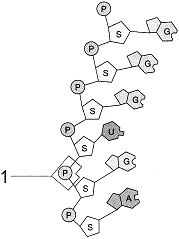When you hit your "funny bone," what are you hitting?
A. acromion process
B. head of ulna
C. deltoid tuberosity
D. glenoid cavity
E. olecranon process
Answer: E
You might also like to view...
You observe a houseplant on your window sill bending toward the bright afternoon sunlight. Being knowledgeable, you wish to explain the molecular events of the phototropic response to your friend. What is the correct sequence that you would describe?
I. PHOT1 attains a phosphate group, and changes shape II. cell elongation occurs on the shady side of the plant III. auxin binds its receptor at target tissues IV. light strikes PHOT1 V. PHOT1 stimulates downward auxin transport on the shady side of the plant VI. light strikes stomates, which close, minimizing water loss VII.cells on the illuminated side of the plant become shorter A) VI, VII, II B) VII, II, III, I C) IV, I, V, III, II D) IV, VI, III, VII E) any of these sequences can initiate phototropism
Riboswitches are alternative RNA structures mediated by the binding of molecules to the RNA. One example of a riboswitch is the intrinsic terminator hairpin (stem-loop) structure that may form in specific sites of newly transcribed RNA
This stable RNA hairpin, if followed by 4–8 uridine residues at the 3' end, is a signal for transcriptional termination of that RNA. The termination of transcription involves interactions of the RNA polymerase, the hairpin, and the template strand sequence. RNA polymerase reads the DNA template strand 3' to 5' while synthesizing the new (nascent) RNA strand 5' to 3'. Which of the following DNA sequences, when transcribed, will most likely form an intrinsic transcription termination RNA structure? A. 3' AAAAAAUUUUUU TTTTT 5' B. 3' ACCCCCATGGGGGAAAAAA 5' C. 3' GGGGGGTTTCCCCCTTTTTT 5' D. 3' ACGACCCGGACGGGGGGG 5' E.3' TTTTTTCCCCCCAAAGGGGGG 5'
Which of the following does not impact an enzyme's function?
a. pH b. temperature c. absence of cofactors d. allosteric interactions e. excess product
The molecular fragment (the G, U and A’s) represented in the accompanying figure is:

a. ATP.
b. RNA.
c. DNA.
d. a nucleotide.
e. a polysaccharide.